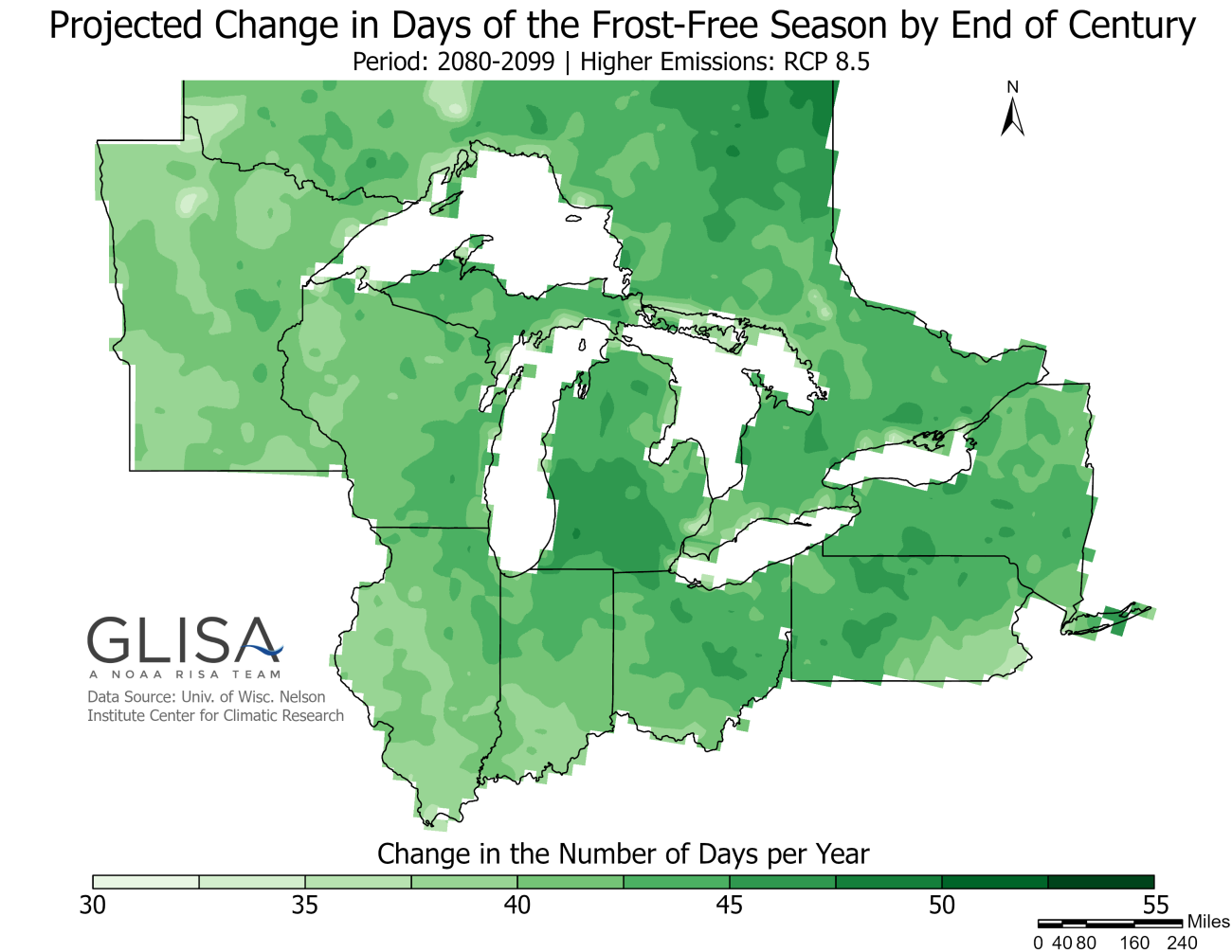Detroit expects more extreme heat, flooding amid climate change

From sunshine and 55-plus degree weather to snow and freezing temperatures just a few days later, climate change is affecting winter in the Motor City.
This winter is one of the top 10 warmest on record for Detroit, and the city has received a foot less snow than the average for this time of year, according to Ian Lee, a meteorologist for the National Weather Service.
“We’ve had a little over 19 inches of snow and normally through this point in the season we’d be at 31 inches,” Lee told BridgeDetroit, based on averages from historical records going back to the late 1800s.
Related:
- What winter? Michigan farmers, anglers hit hard by warm temperatures
- Report aims to prepare Great Lakes states for effects of climate change
- With growing backlash to wind energy, Michigan turns to solar power
The sunshine and warm weather last week was welcomed by some Detroiters, but experts say it’s part of a larger climate change crisis caused by human activities that release greenhouse gas emissions, like burning fossil fuels for transportation and electricity. The change will have multiple impacts on Detroit, from an increased possibility of fatal heat waves and incidences of severe flooding to disruption in the parks and Detroit River ecosystems.
Across the Midwest, winter is disappearing, with temperatures now 4 degrees Fahrenheit warmer from December to February than they were decades ago. Overall, in the last 50 years the Midwest has warmed an average of 2.6 degrees F, and the trend is expected to continue. If greenhouse gas emissions continue to increase, researchers have projected that average temperatures in the Great Lakes region could increase 6 to 11 degrees F by the end of the century.

“The two main things we see coming (for Detroit) are flooding and heat,” said Ricky Ackerman, chief sustainability officer for Eastside Community Network, or ECN.
Low-income individuals and people of color are, and will be, disproportionately impacted, like Black homeowners who face a higher risk of severe flooding due to historical redlining and present day inadequacies at the Federal Emergency Management Agency.
Extreme heat days, Ackerman said, “have the potential to do a lot more harm to our communities,” given that historically Detroit doesn’t have extensive experience with them. Nearly half of Detroiters don’t have air conditioning, according to a 2021 study.
And although there wasn’t a flooding event last year as severe as what the city experienced in 2021, Ackerman said ECN consistently hears from residents about basement flooding.
To address climate change, ECN is working on solar panels and battery storage, and stormwater management and green infrastructure, to ensure energy and climate resilience at The Stoudamire, its on-site community center. The nonprofit has also started the Resilient Eastside Initiative, a project to connect with community partners to develop similar energy resilience hubs across the city.

ECN is one of several grassroots organizations in Detroit that have been chipping away at the problems for years, six of which were selected as members of the Justice40 Accelerator, a philanthropic-funded program that provides support to environmental justice organizations across the country led by people of color.
The six Detroit organizations, out of 100 nationwide, are: EcoWorks, Eastside Community Network, BLVD Harambee Detroit, Detroit Future City, GreenDoor Initiative, and in Highland Park, the Highland Park Community Crisis Coalition.
The City of Detroit has been stepping up its own efforts, too. In 2019, the city created a roadmap to address climate change and increase resiliency, under the leadership of Joel Howrani Heeres, the city’s sustainability director from 2017 to 2022. Since Heeres’ departure last year, the city has been without a director, but expects to hire a new one by early March.
“Climate change will affect those in the City of Detroit, we’ve already seen it with 100-year floods happening just a couple of years apart,” said Trisha Stein, who oversees Detroit’s sustainability initiatives as the city’s chief strategy officer.
“The effects are here now, so we need to get on top of it, and start tackling it, building off the good work that we’ve done and continuing to be on that path,” she told BridgeDetroit.
Sustainability initiatives for the city fall into five main categories: Electric vehicles, energy efficiency, renewable energy, and resiliency/protecting vulnerable citizens, according to Stein.
In 2019 the city passed an ordinance to reduce the amount of greenhouse gas emissions from city operations. The ordinance mandates that compared to 2012 levels the city must cut greenhouse gas emissions 35% by 2024, 75% by 2034, and 100% by 2050.
The first benchmark is next year, but Stein was unable to confirm if it will be met.
“We are in the process right now of evaluating those targets,” Stein said.
Ackerman said a huge problem with the City of Detroit’s approach to climate change is that everything is “siloed” with not enough coordination between Detroit Homeland Security & Emergency Management and the Detroit Water and Sewerage Department and other departments.
“Things are still very siloed and we’re not going to get to the future we need to be in if that continues to be the case,” Ackerman said.
The city recently started working with a new University of Michigan clinic created to help Detroit address climate change, the SEAS Sustainability Clinic which launched in 2021.
The clinic’s first partner was Jefferson East, Inc, a neighborhood organization serving low-income residents on Detroit’s east side.
Initially, the clinic focused on air quality issues – last year Detroit received an “F” from the American Lung Association in its annual air quality report, and asthma rates in the city are 46% higher than the state’s average. But then, in June 2021, Detroit experienced its second flood, likely to occur just once in 500 years, in less than a decade. Half a foot of rain fell in just five hours, filling thousands of Detroiters’ homes with water and sewage and earning a federal disaster declaration from President Joe Biden.
“When the flooding happened we very quickly pivoted to form our first partnership in support of Jefferson East, who were kind of in the epicenter of the communities impacted by the flooding and the wastewater in folks’ homes,” said Kerry Duggan, who is founding director of the clinic and also serves on Gov. Gretchen Whitmer’s Council on Climate Solutions.
With climate change, heavier rains are expected. As the air gets warmer, it can hold more water: about 4% more water per Fahrenheit degree increase.
More rain and the rise in temperatures means a number of effects for Detroit’s ecosystems and related recreational activities, like ice fishing and special winter celebrations.
Last week, Rouge Park rebranded its Winter Fest as a Spring Fest, crossing out “winter” on its flier, and swapping activities like snowshoeing with hiking because of the warmer temperatures.
“With climate change, it just seems like the weather is getting more chaotic,” said Sally Petrella, president of the Friends of Rouge Park, a nonprofit that advocates for the wellbeing of the park.
Last year, for example, Rouge Park planned to do a controlled burn to help curb invasive species, but it snowed, preventing the group from doing so. Warm winters also mean invasive species come earlier in the season at Rouge Park, like garlic mustard, and previously unseen porcelain berry.
Lee from the weather service said although the winter has been mild so far, that could change.
“It does happen from time to time that we can be below normal at this point in February but all it takes is one or two big snow events to get us back to normal,” said Lee. “We’re just going to have to see how things play out.”
Michigan Environment Watch
Michigan Environment Watch examines how public policy, industry, and other factors interact with the state’s trove of natural resources.
- See full coverage
- Subscribe
- Share tips and questions with Bridge environment reporter Kelly House
Michigan Environment Watch is made possible by generous financial support from:
Our generous Environment Watch underwriters encourage Bridge Michigan readers to also support civic journalism by becoming Bridge members. Please consider joining today.
See what new members are saying about why they donated to Bridge Michigan:
- “In order for this information to be accurate and unbiased it must be underwritten by its readers, not by special interests.” - Larry S.
- “Not many other media sources report on the topics Bridge does.” - Susan B.
- “Your journalism is outstanding and rare these days.” - Mark S.
If you want to ensure the future of nonpartisan, nonprofit Michigan journalism, please become a member today. You, too, will be asked why you donated and maybe we'll feature your quote next time!






